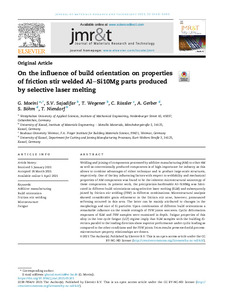On the influence of build orientation on properties of friction stir welded AleSi10Mg parts produced by selective laser melting
| dc.date.accessioned | 2023-04-21T06:26:41Z | |
| dc.date.available | 2023-04-21T06:26:41Z | |
| dc.date.issued | 2021-04-06 | |
| dc.identifier | doi:10.17170/kobra-202304207862 | |
| dc.identifier.uri | http://hdl.handle.net/123456789/14613 | |
| dc.language.iso | eng | |
| dc.rights | Attribution-NonCommercial-NoDerivatives 4.0 International | * |
| dc.rights.uri | http://creativecommons.org/licenses/by-nc-nd/4.0/ | * |
| dc.subject | Additive manufacturing | eng |
| dc.subject | Build orientation | eng |
| dc.subject | Friction stir welding | eng |
| dc.subject | Microstructure | eng |
| dc.subject | Fatigue | eng |
| dc.subject.ddc | 600 | |
| dc.title | On the influence of build orientation on properties of friction stir welded AleSi10Mg parts produced by selective laser melting | eng |
| dc.type | Aufsatz | |
| dcterms.abstract | Welding and joining of components processed by additive manufacturing (AM) to other AM as well as conventionally produced components is of high importance for industry as this allows to combine advantages of either technique and to produce large-scale structures, respectively. One of the key influencing factors with respect to weldability and mechanical properties of AM components was found to be the inherent microstructural anisotropy of these components. In present work, the precipitation-hardenable Al–Si10Mg was fabricated in different build orientations using selective laser melting (SLM) and subsequently joined by friction stir welding (FSW) in different combinations. Microstructural analysis showed considerable grain refinement in the friction stir zone, however, pronounced softening occurred in this area. The latter can be mainly attributed to changes in the morphology and size of Si particles. Upon combination of different build orientations a remarkable influence on the tensile strength of FSW joints was seen. Cyclic deformation responses of SLM and FSW samples were examined in depth. Fatigue properties of this alloy in the low-cycle fatigue (LCF) regime imply that SLM samples with the building direction parallel to the loading direction show superior performance under cyclic loading as compared to the other conditions and the FSW joints. From results presented solid process-microstructure-property relationships are drawn. | eng |
| dcterms.accessRights | open access | |
| dcterms.creator | Moeini, Ghazal | |
| dcterms.creator | Sajadifar, Seyed Vahid | |
| dcterms.creator | Wegener, Thomas | |
| dcterms.creator | Rössler, Christian | |
| dcterms.creator | Gerber, A. | |
| dcterms.creator | Böhm, Stefan | |
| dcterms.creator | Niendorf, Thomas | |
| dcterms.extent | 1446-1460 | |
| dc.relation.doi | doi:10.1016/j.jmrt.2021.03.101 | |
| dc.subject.swd | Materialermüdung | ger |
| dc.subject.swd | Rapid Prototyping <Fertigung> | ger |
| dc.subject.swd | Rührreibschweißen | ger |
| dc.type.version | publishedVersion | |
| dcterms.source.identifier | eissn:2214-0697 | |
| dcterms.source.journal | Journal of Materials Research and Technology : jmr&t | eng |
| dcterms.source.volume | Volume 12 | |
| kup.iskup | false |
Dateien zu dieser Ressource
Das Dokument erscheint in:
-
Publikationen [3]


